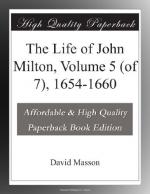Round about Cromwell, even through the First Protectorate, there had been, as we have abundantly seen, much of the splendour and equipage of sovereignty. The phrases “His Highness’s Court” and “His Highness’s Household” had become quite familiar. On all public occasions he was attended and addressed most ceremoniously; when he rode out in state it was with life-guards about him, outriders in front, and coaches following; and the Order-Books of the Council prove that his relations to the Council were regulated by careful etiquette, and that his personal attendance at any of their meetings was regarded as a distinction. One observes also, as with Cromwell’s approval, and in evidence of the conservatism that had been growing upon himself, a retention or even multiplication of aristocratic forms in his court and government. He had conferred knighthoods less sparingly than at first, though still rather sparingly;[1] in mentions of any of the old nobility, whether those that had become Oliverian and were to be seen at Whitehall, or those who lived in retirement, their old titles were scrupulously preserved,—e.g. “The Marquis of Hertford,” “The Earl of Warwick,” “The Earl of Mulgrave,” “The Lord Viscount Lisle,” “The Right Honourable the Lord Broghill”; and not only were official or courtesy titles still recognised, as by calling Fleetwood “My Lord Deputy,” Whitlocke “Lord Commissioner Whitelocke,” Fiennes “Lord Commissioner Fiennes,” and Lawrence “Lord President Lawrence,” but there had been a curious extension of usage in this last particular. The Protector’s sons had become respectively “The Lord Richard Cromwell” and “The Lord Henry Cromwell” in the newspapers and in public correspondence; and, for some reason or other, probably on account of places held in his Highness’s Household or Ministry apart from the Council, at least two of the Councillors had of late received similar courtesy-promotion. From the beginning of 1655 Lambert had ceased to be called “Major-General Lambert,” and had become “Lord Lambert,” and from the beginning of 1656 “Mr. Strickland” had passed into “Lord Strickland.” They are so named both in the Council Order-Books and in the Journals of the First Session of the Second Parliament.
[Footnote 1: Here is a list of Cromwell’s Knights of the First Protectorate, so far as I have ascertained them:—Lord Mayor Thomas Viner (Feb. 8, 1653-4); John Copleston (June 1, 1655); Colonel John Reynolds (June 11, 1655); Lord Mayor Sir Christopher Pack (Sept. 20, 1655); Colonel Thomas Pride, of ‘Pride’s Purge’ celebrity (Jan. 17, 1655-6); Major-General John Barkstead, Lieutenant of the Tower (Jan. 19, 1655-6); M. Coyet, of the Swedish Embassy (April 15, 1656); Richard Combe (Aug. 1656); Lord Mayor Dethicke and George Fleetwood, Esq. of Bucks (both Sept. 15, 1656); Ambassador Lockhart, Lord Mayor Robert Tichbourne, Sheriff James Calthorpe, and Lislebone Long, Esq., Recorder of London (all Dec. 10, 1656); Colonel James Whitlocke, a son of Bulstrode Whitlocke (Jan. 6, 1656-7); Thomas Dickson, of York (March 3, 1656-7); Richard Stayner (June 11, 1657).]




